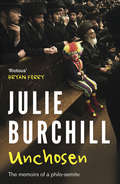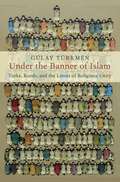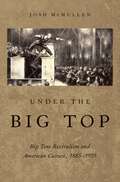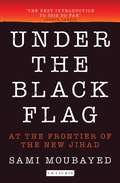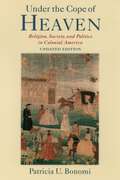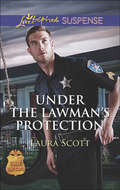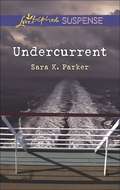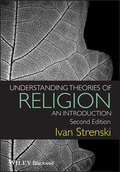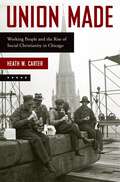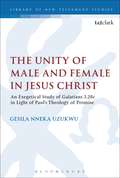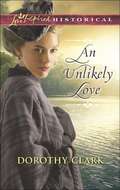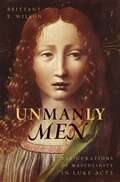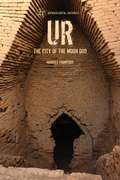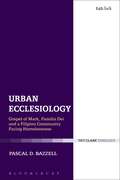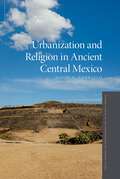- Table View
- List View
The Ultimate Three Minutes: The Story of Two Great Human Watersheds - Their Preparation and Their Coinciding
by The Very Revd William CummingsThe Ultimate Three Minutes is a statement of Christian theology in terms of "Salvation History", introducing the functions of Abraham, Moses, Second Isaiah and the Psalms; and placing in historical context the life, crucifixion and resurrection of Jesus Christ his uniqueness, the formation of the Gospels, and the Eucharist as the identifying thread which binds the redemptive or salvation process into a coherent whole and vivifies the Christian hope. This presentation of basic Christian Gospel theology is carried within a simplistic account of the history of the Ancient World, written in the style of a continuous narrative, with digressions into special topics such as the Psalms, Augustus and Providence, the Sixth Chapter of St John's Gospel, and the Northern Frontier. It also features a parable drawn from modern science. The title of the book borrows from two distinguished scientists. In The First Three Minutes Steven Weinberg describes the developments of the first three minutes of the universe, following the explosion of the "Big Bang" 13.8 billion years ago. In The Last Three Minutes Paul Davies describes the final subsidence of the universe into entropy and heat death. The Ultimate Three Minutes: The Story of Two Great Human Watersheds Their Preparation and Their Coinciding provides a humanitarian parallel. The title embodies a value judgement, namely the need of the human race for redemption, and the achievement of that redemption by Jesus Christ, the Anointed Saviour, on his Cross. The "Ultimate Three Minutes" is the final three minutes before Jesus Christ expelled his final breath, when the suffering and the cost of the redemption of mankind was at its most heavy and precarious.
Unafraid: 365 Days Without Fear
by Gracie MaloneA 365-day devotional that will encourage and help readers overcome the fear that consumes, disturbs, and paralyzes them.To live without fear is one of the most challenging goals you can make in your life. Fear lurks in the deep recesses of the human heart and surprises even the most mature Christian. There are over 400 instances in the Bible of God telling His children to not be afraid. If repetition of a matter has anything to do with importance, God decided this was a big one. But rather than being a command or admonition, the tone spoken in turn by God, angels, and disciples is compelling and encouraging, like a parent comforting a fearful child. In Unafraid, Gracie Malone brings light, a touch of humor, stories, quotes, prayers, and encouragement to everyone who is fighting to trust in the only One who can take their fear away.
Unchosen: The Memoirs Of A Philo-semite
by Julie BurchillWhat if your first love was not one person but an entire culture?This is a loud and heartfelt celebration of one woman's relationship with the Jewish people. Growing up as a blonde, popular, West Country schoolgirl, Julie Burchill was the unlikeliest convert to militant Zionism but learning of the cruelty the Jewish people faced throughout history turned her into their biggest champion. From her marriage to a 'not Jewish enough husband' to drunken holidays in Israel, arguments with lesbian rabbis to being banned from her local synagogue, this is a brilliantly funny and unflinchingly honest account of a philo-Semite that will shock and delight in equal parts. Join Julie as she examines her 40-year obsession with the Jewish people and recounts a love affair that is as hedonistic, passionate and outspoken as its author. This is a frivolous book about a serious subject that is now more important than ever. It's An Education, but with more sex, more violence and a lot more Jews.
Under the Banner of Islam: Turks, Kurds, and the Limits of Religious Unity (Religion and Global Politics)
by Gülay TürkmenSunni Islam has played an ambivalent role in Turkey's Kurdish conflict--both as a conflict resolution tool and as a tool of resistance. Under the Banner of Islam uses Turkey as a case study to understand how religious, ethnic, and national identities converge in ethnic conflicts between co-religionists. Gülay Türkmen asks a question that informs the way we understand religiously homogeneous ethnic conflicts today: Is it possible for religion to act as a resolution tool in these often-violent conflicts? In search for answers to this question, in Under the Banner of Islam, Türkmen journeys into the inner circles of religious elites from different backgrounds: non-state-appointed local Kurdish meles, state-appointed Kurdish and Turkish imams, heads of religious NGOs, and members of religious orders. Blending interview data with a detailed historical analysis that goes back as far as the nineteenth century, she argues that the strength of Turkish and Kurdish nationalisms, the symbiotic relationship between Turkey's religious and political fields, the religious elites' varying conceptualizations of religious and ethnic identities, and the recent political developments in the region (particularly in Syria) all contribute to the complex role religion plays in the Kurdish conflict in Turkey. Under the Banner of Islam is a specific story of religion, ethnicity, and nationalism in Turkey's Kurdish conflict, but it also tracks a broader narrative of how ethnic and religious identities are negotiated when resolving conflicts.
Under the Big Top: Big Tent Revivalism and American Culture, 1885-1925
by Josh McMullenUnder the Big Top examines the immensely popular big tent revivals of turn-of-the-twentieth-century America and develops a new framework for understanding Protestantism in this transformative period of the nation's history. Contemporary critics of the revivalists often depicted them as anxious and outdated religious opponents of a modern, urban nation. Early historical accounts likewise portrayed tent revivalists as Victorian hold-outs, bent on re-establishing nineteenth-century values and religion in a new America. In this revisionist work, Josh McMullen argues that, contrary to these stereotypes, big tent revivalists actually participated in the shift away from Victorianism and helped in the construction of a new consumer culture in the United States. How did the United States became the most consumer-driven and yet one of the most religious societies in the western world? McMullen shows that revivalists and their audiences reconciled the Protestant ethic of salvation with the emerging consumer ethos by cautiously unlinking Christianity from Victorianism and joining it to the new, emerging consumer culture. Under the Big Top helps to explain the continued appeal of both the therapeutic and the salvific worldview to many Americans as well as the ambivalence that accompanies this combination.
Under the Black Flag: An Exclusive Insight into the Inner Workings of ISIS
by Sami MoubayedThe Islamic State movement (ISIS/ISIL/IS) burst onto the world stage in 2014. From its heartland in Syria, where it arose from the chaos of the Syrian Revolt, the organisation has expanded in ideology and membership and now poses a significant threat to the region, if not to the wider world. Moubayed, a Beirut-based journalist who has been analysing Syria and the region for 20 years, has unrivalled access to the movement and its participants. His book is the first inside account of an organisation which has dominated the headlines with a dangerous mix of barbarity and military prowess. In looking at the historical background of ISIS: where it came from, how it evolved, where it stands today and what its aims are for the future to reveal, it will provide, for the first time, a fully-fledged picture of what lies at the heart of the Islamic State.
Under the Cope of Heaven: Religion, Society, and Politics in Colonial America
by Patricia U. BonomiIn this pathbreaking study, Patricia Bonomi argues that religion was as instrumental as either politics or the economy in shaping early American life and values. Looking at the middle and southern colonies as well as at Puritan New England, Bonomi finds an abundance of religious vitality through the colonial years among clergy and churchgoers of diverse religious background. The book also explores the tightening relationship between religion and politics and illuminates the vital role religion played in the American Revolution. A perennial backlist title first published in 1986, this updated edition includes a new preface on research in the field on African Americans, Indians, women, the Great Awakening, and Atlantic history and how these impact her interpretations.
Under the Lawman's Protection: Under The Lawman's Protection Buried Calculated Risk (SWAT: Top Cops #3)
by Laura ScottA PROMISE TO PROTECT
Undercurrent: Countdown To Danger Shattered Haven Undercurrent (Mills And Boon Love Inspired Suspense Ser.)
by Sara K. ParkerTRAPPED AT SEA
Understanding Theories of Religion: An Introduction
by Ivan StrenskiFeaturing comprehensive updates and additions, the second edition of Understanding Theories of Religion explores the development of major theories of religion through the works of classic and contemporary figures. • A new edition of this introductory text exploring the core methods and theorists in religion, spanning the sixteenth-century through to the latest theoretical trends • Features an entirely new section covering religion and postmodernism; race, sex, and gender; and religion and postcolonialism • Examines the development of religious theories through the work of classic and contemporary figures from the history of anthropology, sociology, psychology, philosophy, and theology • Reveals how the study of religion evolved in response to great cultural conflicts and major historical events • Student-friendly features include chapter introductions and summaries, biographical vignettes, a timeline, a glossary, and many other learning aids
Understanding Theories of Religion: An Introduction
by Ivan StrenskiFeaturing comprehensive updates and additions, the second edition of Understanding Theories of Religion explores the development of major theories of religion through the works of classic and contemporary figures. • A new edition of this introductory text exploring the core methods and theorists in religion, spanning the sixteenth-century through to the latest theoretical trends • Features an entirely new section covering religion and postmodernism; race, sex, and gender; and religion and postcolonialism • Examines the development of religious theories through the work of classic and contemporary figures from the history of anthropology, sociology, psychology, philosophy, and theology • Reveals how the study of religion evolved in response to great cultural conflicts and major historical events • Student-friendly features include chapter introductions and summaries, biographical vignettes, a timeline, a glossary, and many other learning aids
Unexpected Family: The Amish Bride Falling For The Mom-to-be Unexpected Family (Mills And Boon Love Inspired Ser.)
by Jill KemererHis Surprise Daughter
The Unintended Reformation: How a Religious Revolution Secularized Society
by Brad S. GregoryIn a work that is as much about the present as the past, Brad Gregory identifies the unintended consequences of the Protestant Reformation and traces the way it shaped the modern condition over the course of the following five centuries. A hyperpluralism of religious and secular beliefs, an absence of any substantive common good, the triumph of capitalism and its driver, consumerism—all these, Gregory argues, were long-term effects of a movement that marked the end of more than a millennium during which Christianity provided a framework for shared intellectual, social, and moral life in the West. Before the Protestant Reformation, Western Christianity was an institutionalized worldview laden with expectations of security for earthly societies and hopes of eternal salvation for individuals. The Reformation’s protagonists sought to advance the realization of this vision, not disrupt it. But a complex web of rejections, retentions, and transformations of medieval Christianity gradually replaced the religious fabric that bound societies together in the West. Today, what we are left with are fragments: intellectual disagreements that splinter into ever finer fractals of specialized discourse; a notion that modern science—as the source of all truth—necessarily undermines religious belief; a pervasive resort to a therapeutic vision of religion; a set of smuggled moral values with which we try to fertilize a sterile liberalism; and the institutionalized assumption that only secular universities can pursue knowledge. The Unintended Reformation asks what propelled the West into this trajectory of pluralism and polarization, and finds answers deep in our medieval Christian past.
UNION MADE P: Working People and the Rise of Social Christianity in Chicago
by Heath W. CarterIn Gilded Age America, rampant inequality gave rise to a new form of Christianity, one that sought to ease the sufferings of the poor not simply by saving their souls, but by transforming society. In Union Made, Heath W. Carter advances a bold new interpretation of the origins of American Social Christianity. While historians have often attributed the rise of the Social Gospel to middle-class ministers, seminary professors, and social reformers, this book places working people at the very center of the story. The major characters--blacksmiths, glove makers, teamsters, printers, and the like--have been mostly forgotten, but as Carter convincingly argues, their collective contribution to American Social Christianity was no less significant than that of Walter Rauschenbusch or Jane Addams. Leading readers into the thick of late-19th-century Chicago's tumultuous history, Carter shows that countless working-class believers participated in the heated debates over the implications of Christianity for industrializing society, often with as much fervor as they did in other contests over wages and the length of the workday. The city's trade unionists, socialists, and anarchists advanced theological critiques of laissez faire capitalism and protested "scab ministers" who cozied up to the business elite. Their criticisms compounded church leaders' anxieties about losing the poor, such that by the turn-of-the-century many leading Christians were arguing that the only way to salvage hopes of a Christian America was for the churches to soften their position on "the labor question." As denomination after denomination did just that, it became apparent that the Social Gospel was, indeed, ascendant--from below. At a time when the fate of the labor movement and rising economic inequality are once more pressing social concerns, Union Made opens the door for a new way forward--by changing the way we think about the past.
The Unity of Male and Female in Jesus Christ: An Exegetical Study of Galatians 3.28c in Light of Paul's Theology of Promise (The Library of New Testament Studies)
by Gesila Nneka UzukwuThis detailed exegetical study of Gal 3.28c in the light of 3.14-29 and 4.21-31 shows not only how integral this verse is to chapters 3 and 4 of the letter, but also that it is the key to understanding Paul's theological argument of promise in Galatians. Paul's use of the story of Abraham in 3.14-29 and of Sarah in 4.21-31 in light of God's promise to the patriarch and the matriarch in Genesis 17 have implications displays the joint role of Abraham and Sarah in bringing about the promise, and underscores the unity of the believers in Christ. In light of this, Uzukwu examines important aspects of the history of the interpretation of Gal 3.28c. Uzukwu sheds light on the link between Gal 3:28 and the three expressions of gratitude found in Greek writings. Links are also revealed to the three blessings of gratitude that appear at the beginning of the Jewish cycle of morning prayers, Gen 1.27c (in the Septuagint), and the alleged pre-Pauline baptismal formula. She goes further to demonstrate how 3.28c is related to the unity of Galatians 3-4, focusing on the theme of the promise as the text discusses the effect of the Christ event in bringing about the fulfillment of that promise.
An Unlikely Love: Wagon Train Reunion An Unlikely Love From Boss To Bridegroom The Doctor's Undoing (Mills And Boon Love Inspired Historical Ser.)
by Dorothy ClarkIrresistible Adversary
UNMANLY MEN C: Refigurations of Masculinity in Luke-Acts
by Brittany E. WilsonNew Testament scholars typically assume that the men who pervade the pages of Luke's two volumes are models of an implied "manliness." Scholars rarely question how Lukan men measure up to ancient masculine mores, even though masculinity is increasingly becoming a topic of inquiry in the field of New Testament and its related disciplines. Drawing especially from gender-critical work in classics, Brittany Wilson addresses this lacuna by examining key male characters in Luke-Acts in relation to constructions of masculinity in the Greco-Roman world. Of all Luke's male characters, Wilson maintains that four in particular problematize elite masculine norms: namely, Zechariah (the father of John the Baptist), the Ethiopian eunuch, Paul, and, above all, Jesus. She further explains that these men do not protect their bodily boundaries nor do they embody corporeal control, two interrelated male gender norms. Indeed, Zechariah loses his ability to speak, the Ethiopian eunuch is castrated, Paul loses his ability to see, and Jesus is put to death on the cross. With these bodily "violations," Wilson argues, Luke points to the all-powerful nature of God and in the process reconfigures--or refigures--men's own claims to power. Luke, however, not only refigures the so-called prerogative of male power, but he refigures the parameters of power itself. According to Luke, God provides an alternative construal of power in the figure of Jesus and thus redefines what it means to be masculine. Thus, for Luke, "real" men look manifestly unmanly. Wilson's findings in Unmanly Men will shatter long-held assumptions in scholarly circles and beyond about gendered interpretations of the New Testament, and how they can be used to understand the roles of the Bible's key characters.
Untraceable: Stranded Untraceable Dangerous Inheritance (Mountain Cove #2)
by Elizabeth GoddardNO WAY OUT
Unwrap Me: A Stark Ever After Novella (ebook) (Stark Series #19)
by J. KennerNew York Times bestselling author J. Kenner continues her beloved Stark series with a sensual Stark Ever After novella for Nikki and Damien Stark as they turn up the heat in their holiday celebrations. For fans of Fifty Shades of Grey, Sylvia Day, Meredith Wild and Jodi Ellen Malpas. Damien Stark is my greatest Christmas wish come true. Immensely powerful and devastatingly sexy, he can undo me with the slightest touch, and with just one glance, he can see straight into my soul. We both have dark secrets, twisted pieces of our pasts that only the other one understands. Though our fierce love and passion keeps me alive, sometimes I wonder what would've happened if Damien and I hadn't met in exactly the way we did. How would my life have been different? Would another man have laid claim to my body and my heart? Or were Damien and I destined to be together no matter the cost? Find out how it all began for Damien and Nikki in J. Kenner's hot and addictive bestselling Stark series: Release Me, Claim Me, Complete Me, Take Me, Have Me, Play My Game and Seduce Me.Return to the smoking hot Stark world with the Stark International trilogy: Say My Name, On My Knees and Under My Skin is the explosively emotional story of Jackson Steele and Sylvia Brooks.Don't miss J. Kenner's sizzling Most Wanted series of three enigmatic and powerful men, and the striking women who can bring them to their knees: Wanted, Heated and Ignited.
Ur: The City of the Moon God (Archaeological Histories)
by Harriet CrawfordThe ancient Mesoptamian city of Ur was a Sumerian city state which flourished as a centre of trade and civilisation between 2800–2000 BCE. However, in the recent past it suffered from the disastrous Gulf war and from neglect. It still remains a potent symbol for people of all faiths and will have an important role to play in the future.This account of Ur's past looks at both the ancient city and its evolution over centuries, and its archaeological interpretation in more recent times. From the 19th century explorers and their identification of the site of Mukayyar as the Biblical city of Ur, the study proceeds to look in detail at the archaeologist Leonard Woolley and his key discoveries during the 1920s and 30s. Using the findings as a framework and utilising the latest evidence from environmental, historical and archaeological studies, the volume explores the site's past in chronological order from the Ubaid period in the 5th millennium to the death of Alexander. It looks in detail at the architectural remains: the sacred buildings, royal graves and also the private housing which provides a unique record of life 4000 years ago. The volume also describes the part played by Ur in the Gulf war and discusses the problems raised for archaeologists in the war's aftermath.
Ur: The City of the Moon God (Archaeological Histories)
by Harriet CrawfordThe ancient Mesoptamian city of Ur was a Sumerian city state which flourished as a centre of trade and civilisation between 2800–2000 BCE. However, in the recent past it suffered from the disastrous Gulf war and from neglect. It still remains a potent symbol for people of all faiths and will have an important role to play in the future.This account of Ur's past looks at both the ancient city and its evolution over centuries, and its archaeological interpretation in more recent times. From the 19th century explorers and their identification of the site of Mukayyar as the Biblical city of Ur, the study proceeds to look in detail at the archaeologist Leonard Woolley and his key discoveries during the 1920s and 30s. Using the findings as a framework and utilising the latest evidence from environmental, historical and archaeological studies, the volume explores the site's past in chronological order from the Ubaid period in the 5th millennium to the death of Alexander. It looks in detail at the architectural remains: the sacred buildings, royal graves and also the private housing which provides a unique record of life 4000 years ago. The volume also describes the part played by Ur in the Gulf war and discusses the problems raised for archaeologists in the war's aftermath.
Urban Ecclesiology: Gospel of Mark, Familia Dei and a Filipino Community Facing Homelessness (Ecclesiological Investigations)
by Pascal D. BazzellPascal D. Bazzell brings the marginal ecclesiology of a Filipino ecclesial community facing homelessness (FECH) into contemporary ecclesiological conversation in order to deepen the ecumenical understanding of today's ecclesial reality. He contributes relevant data to support a theory of an ecclesial-oriented paradigm that fosters ecclesial communities within homeless populations. There is an extensive dialogue occurring between ecclesiologies, church planting theories or urban missions and the urban poor. Yet the situation with the homeless population is almost entirely overlooked. The majority of urban mission textbooks do not acknowledge an ecclesial-oriented state of being and suggest that the street-level environment is a place where no discipleship can occur and no church should exist. By presenting the FECH's case study Bazzell emphasizes that it is possible to live on the streets and to grow in the faith of God as an ecclesial community. To be able to describe the FECH's ecclesial narrative, Bazzell develops a local ecclesiological methodology that aims to bridge the gap between more traditional systematic and theoretical (ideal) ecclesiology and practical oriented ecclesiology (e.g. congregational studies) in order to hold together theological and social understandings of the church in its local reality. He articulates a theological framework for the FECH to reflect on who they are (the essence of identity studies), who they are in relationship to God (the essence of theological studies), and what that means for believers in that community as they relate to God and to each other in ways that are true to who they are and to who God intends them to be (the essence of ecclesial studies). The research provides a seldom-heard empirical tour into the FECH's social world and communal identity. The theological findings from the FECH's hermeneutical work on the Gospel of Mark reveal an understanding of church being developed as gathering around Jesus that creates a space for God's presence to be embodied in their ordinary relationships and activities and to invite others to participate in that gathering. Moreover, it addresses ecclesial issues of the supernatural world; honor/shame values; and further develop the neglected image of the familia Dei in classical ecclesiology that encapsulates well the FECH's nature, mission and place.
Urban Ecclesiology: Gospel of Mark, Familia Dei and a Filipino Community Facing Homelessness (Ecclesiological Investigations)
by Pascal D. BazzellPascal D. Bazzell brings the marginal ecclesiology of a Filipino ecclesial community facing homelessness (FECH) into contemporary ecclesiological conversation in order to deepen the ecumenical understanding of today's ecclesial reality. He contributes relevant data to support a theory of an ecclesial-oriented paradigm that fosters ecclesial communities within homeless populations. There is an extensive dialogue occurring between ecclesiologies, church planting theories or urban missions and the urban poor. Yet the situation with the homeless population is almost entirely overlooked. The majority of urban mission textbooks do not acknowledge an ecclesial-oriented state of being and suggest that the street-level environment is a place where no discipleship can occur and no church should exist. By presenting the FECH's case study Bazzell emphasizes that it is possible to live on the streets and to grow in the faith of God as an ecclesial community. To be able to describe the FECH's ecclesial narrative, Bazzell develops a local ecclesiological methodology that aims to bridge the gap between more traditional systematic and theoretical (ideal) ecclesiology and practical oriented ecclesiology (e.g. congregational studies) in order to hold together theological and social understandings of the church in its local reality. He articulates a theological framework for the FECH to reflect on who they are (the essence of identity studies), who they are in relationship to God (the essence of theological studies), and what that means for believers in that community as they relate to God and to each other in ways that are true to who they are and to who God intends them to be (the essence of ecclesial studies). The research provides a seldom-heard empirical tour into the FECH's social world and communal identity. The theological findings from the FECH's hermeneutical work on the Gospel of Mark reveal an understanding of church being developed as gathering around Jesus that creates a space for God's presence to be embodied in their ordinary relationships and activities and to invite others to participate in that gathering. Moreover, it addresses ecclesial issues of the supernatural world; honor/shame values; and further develop the neglected image of the familia Dei in classical ecclesiology that encapsulates well the FECH's nature, mission and place.
Urban Multiculture: Youth, Politics and Cultural Transformation in a Global City
by Malcolm JamesThis book explores the transformation of youth and urban culture in neoliberal Britain. Focusing on the reconfiguration of urban culture in relation to race, marginalization and youth politics, James examines the shifting formations of memory, territory, cultural performance and politics.
Urbanization and Religion in Ancient Central Mexico (Oxford Studies in the Archaeology of Ancient States)
by David M. CarballoUrbanization and Religion in Ancient Central Mexico examines the ways in which urbanization and religion intersected in pre-Columbian central Mexico, with a primary focus on the later Formative period and the transition to the Classic period. The major societal transformations of this interval occurred approximately two-thousand years ago and over a millennium before Mexico's best known early civilization, the Aztecs. David M. Carballo presents a synthesis of data from regional archaeological projects and key sites such as Teotihuacan and Cuicuilco, while relying on his own excavations at the site of La Laguna as the central case study. A principal argument is that cities and states developed hand in hand with elements of a religious tradition of remarkable endurance and that these processes were fundamentally entangled. Prevalent religious beliefs and ritual practices created a cultural logic for urbanism, and as populations urbanized they became socially integrated and differentiated following this logic. Nevertheless, religion was used differently over time and by groups and individuals across the spectra of urbanity and social status. The book provides a materially informed history of religion, with the temporal depth that archaeology can provide, and an archaeology of cities that considers religion seriously as a generative force in societal change.


